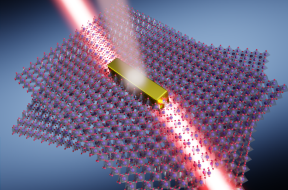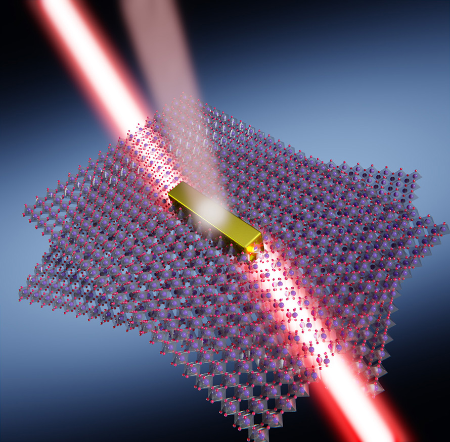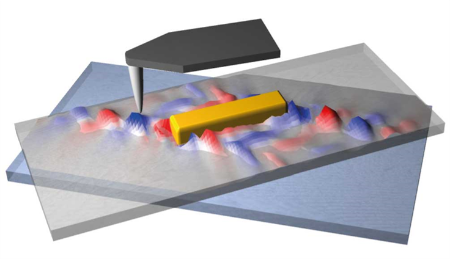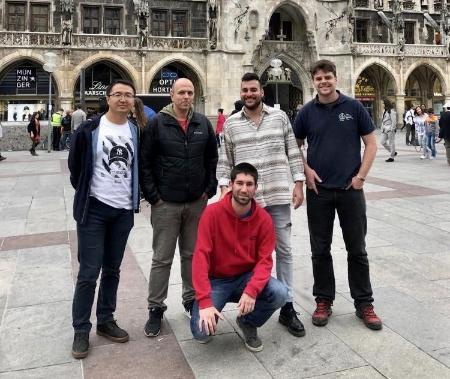The results could boost novel photonic nanotechnologies for sensing and thermal management applications
An international research team led by researchers from University of Oviedo and Center of Research on Nanomaterials and Nanotechnology CINN-CSIC (Spain), Donostia International Physics Center DIPC (Spain) and Institute of Science and Technology IST (Austria) demonstrate control of the propagation of light at the nanoscale – in the form of polaritons: hybrid light-matter waves that exist at the boundary between different media– by stacking together two layers of molybdenum trioxide with a relative twist angle between them. Excitingly, their experiments show that certain twist angles give rise to extreme guiding of light at the nanoscale along specific directions. The results have just been published in the journal Nano Letters.
The long-pursued goal of nano-optics is the effective manipulation of light at the nanoscale (i.e. at sizes about 10,000 times smaller than a human hair), which in the last decade has been intensively tackled by the excitation of polaritons in different natural media, such as metals, polar dielectrics, or artificially engineered materials. Recently, polaritons with strongly anisotropic propagation have been discovered in a variety of van de Waals crystals, including molybdenum trioxide, which offers unprecedented possibilities in the nano-optics field, as polaritons travel in it with very low optical losses. However, despite their extraordinary properties, the direction of propagation of these polaritons is inherently predefined by the structure of the material, thus limiting further practical applications.
Now, a team of researchers from the University of Oviedo, the Center for Research in Nanomaterials and Nanotechnology (CINN-CSIC) and Donostia International Physics Center (DIPC) have experimentally demonstrated that the anisotropic propagation of polaritons in van der Waals materials can be widely controlled and steered by stacking two of their layers with a relative twist angle between them. To do this, the researchers prepared two nanometer-thick layers of molybdenum trioxide by mechanical exfoliation and placed one on top of the other with a fine control in the twist angle employing micro-positioners and an optical microscope. Polaritons were launched in the stack by a rod-like metal antenna and their propagation was visualized by near-field optical microscopy, a nanoimaging technique which has also undergone a rapid development in the last years.
The work demonstrates that there is a certain angle at which the propagation of polaritons is strongly guided along specific directions with no geometrical spreading (diffraction-less). "I was very surprised when I first observed the propagation of polaritons in our samples, it seemed that the twisting angle was triggering some kind of magic and the polaritons were guided along a specific direction without any geometrical spreading", says Jiahua Duan, postdoc affiliated in the Quantum Nano-optics Group. "It is actually an additional tuning knob to control the propagation direction of polaritons with important implications in future information and communication technologies", adds Javier Martín-Sánchez, researcher in the same group.
The possibility of controlling the propagation of light at the nanoscale in van der Waals materials represents also a fundamental building block for the integration of future technologies in nanophotonics with an ultracompact footprint. "These findings can have a remarkable impact on the development of new photonic nanotechnologies with potential for nano-imaging, (bio)-sensing, quantum applications or heat management" says Alexey Nikitin, researcher at the Donostia International Physics Center. "The experimental results fit perfectly our theoretical calculations", highlights Alexey.
Inspired by the recent results obtained on the control of electronic bands in the novel field of "twistronics", the findings reported show that a similar conceptual approach can be extended to the optics realm offering unprecedented capabilities. "With this work we establish the bases for a "twisoptics" field that offers unique possibilities to manipulate light at the nanoscale", concludes Pablo Alonso-González, head of the Quantum Nano-optics Group at the University of Oviedo.
Article details
"Twisted Nano-optics: Manipulating Light at the Nanoscale with Twisted Phonon Polaritonic Slabs"
Jiahua Duan, Nathaniel Capote-Robayna, Javier Taboada-Gutiérrez, Gonzalo Álvarez-Pérez, Iván Prieto, Javier Martín-Sánchez, Alexey Y. Nikitin, and Pablo Alonso-González, Nano Letters, DOI: https://doi.org/10.1021/acs.nanolett.0c01673.
Partner institutions
University of Oviedo: http://www.uniovi.es/
CINN-CSIC (the Spanish National Research Council's Nanomaterials and Nanotechnology Research Centre): https://cinn.es/
Donostia International Physics Center (DIPC): http://dipc.ehu.es/
Austrian Institute of Technology: https://ist.ac.at/en/home/
IKERBASQUE, Basque Foundation for Science: https://www.ikerbasque.net/






